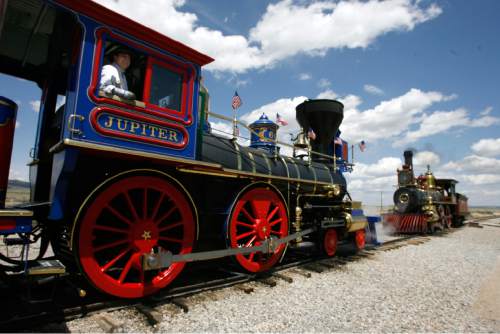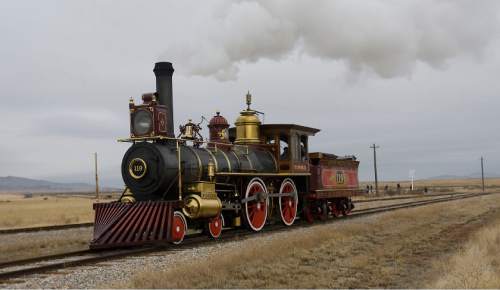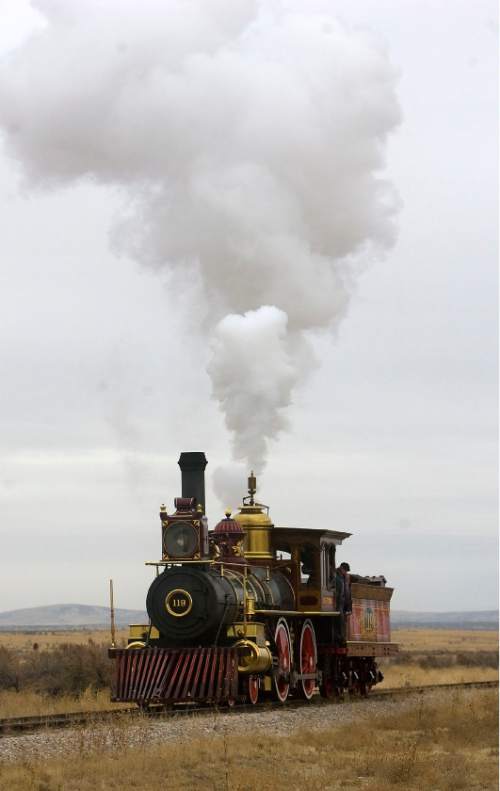This is an archived article that was published on sltrib.com in 2015, and information in the article may be outdated. It is provided only for personal research purposes and may not be reprinted.
Promontory • About 50 miles northwest of Ogden, a small collective is making sure that a nearly 150-year-old tale of American history survives at least another 15 years.
National Park Service engineers at the Golden Spike National Historic Site in Promontory are working alongside contractors to conduct a once-in-every-15-years renovation on two of the site's most prized assets: working replicas of the Union Pacific No. 119 and the Central Pacific Jupiter steam engine locomotives.
The original two engines forever became a part of history when they met at Promontory Summit during the May 10, 1869, Golden Spike ceremony that commemorated completion of the First Transcontinental Railroad.
Constructed between 1863 and 1869, the railroad connected the Pacific
Coast at San Francisco Bay with the existing Eastern U.S. rail network. The railroad revolutionized the American West by establishing a reliable transportation network that brought Western states and territories economic prosperity through the easy, cheap and quick transport of both goods and people.
When the "Last Spike" on the railroad was driven, both the 119 and the Jupiter were there. After continuing their service for another 30-plus years, the two engines were both scrapped in the early 1900s.
But the Park Service figured exact, working replicas of the locomotives could tell the story of the railroad better than any history book, and commissioned a company called O'Connor Engineering Laboratories from Costa Mesa, California, to build the duplicates in 1974.
"They built both locomotives essentially from the rails up," said Richard Carrol, director of the engine shop at Golden Spike. "They're exact replicas, as close as humanly possible to the originals. And that was pretty tricky because not only were the originals both gone, but so were the blueprints."
Carrol said crews had only a few known dimensions of the engines, technical books of the era and plenty of photographs to guide their re-creations.
"From that, they established a scale and by scaling photographs and some of that other information they had available to them, they engineered and redrew 786 drawings, then began construction.," he said
Those replicas were finished in 1979 and have been running in full operation ever since. The Golden Spike crew conducts "steam demonstrations," where the locomotives move on the tracks, every day from May 1 to Columbus Day.
But because the engines are powered by steam, corrosion is an issue and they must be carefully inspected and re-certified every decade-and-a-half.
"Basically, it's maintenance we have to do to follow Federal Railroad Administration standards for steam locomotive operation," Carrol said. "Last time we did this type of work was in 2000."
Carrol said workers from Wasatch Railroad Contractors out of Cheyenne, Wyoming, have come to Box Elder County for about 90 days to perform the renovations.
"They're staying in a Brigham City motel right now," Carrol said of the contractors.
Crews strip the locomotives down to the bare nuts and bolts and use ultrasonic technology to test erosion levels on the metal. They replace hundreds of tubes that transfer steam through the engine, put on a coat of protective primer, about an inch of new insulation and then wrap the engine in a sheet metal jacket.
Carrol said the actual contract work takes about three months, but there's a lot of prep work involved before that work ever takes place.
"We started working right when we shut the locomotives down on Columbus Day," Carrol said. "There's a massive amount of stuff that has to come off (before the renovation can start). All the brass, the running boards, the cabs. We get it to the point where the contractor can come in and do the work."
Carrol said about 3,000 work hours go into the project and the Golden Spike crew depends heavily on volunteers to help complete the project. Americorps and Boy Scouts have both pitched in.
"It's a pretty big undertaking," Carrol said, who also noted the hours and hours of preventive maintenance and upkeep that goes into keeping the engines running. "But we think it's worth it. Nothing else can tell the story of the railroad like these two."







